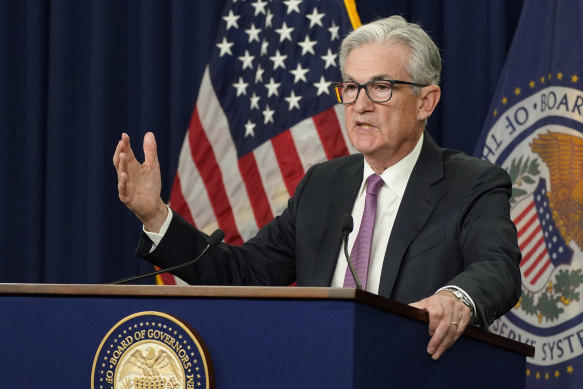While there were some fears that the Fed would add another 75 basis point hike next month, investors now expect a 50 basis point rise.
Essentially, the markets are pricing in more rate increases this year but in smaller increments as the Fed gains confidence that inflation, while still high, is retreating. While there are analysts who think the Fed will still be raising rates next year and that the federal funds rate will peak with a 4 in front of it, the markets are pricing something closer to 3.5 per cent.

There were fears Jerome Powell’s US Fed would add another 75 basis point hike next month but investors now expect a 50 basis point rise.Credit:AP
Sharemarkets are very sensitive to interest rates both because interest-bearing securities are an alternative to equities but also because long bond rates are used to calculate the net present value of future cash flows as a core approach to valuing companies. The lower the yield on the benchmark 10-year government bonds used to discount those cash flows the more they are worth.
If you step back from the shift in the markets since mid-June it would seem that they are signaling that the Fed can bring inflation under control without tightening monetary policy so severely that it plunges the US economy into a deep and prolonged recession. That doesn’t rule out something shallow and short but it’s certainly a more optimistic view that the worst fears earlier this year.
That optimism has been buttressed by the first real signs that the dysfunction in global supply chains that has been a major driver in soaring inflation rates around the world is easing, with the cost of shipping containers across the Pacific, for instance, plummeting to about a third of what it cost a year ago.
It’s also been helped by the fall in the oil price from more than $US123 a barrel to about $US97 a barrel and a consequent decline in US gasoline prices from more than $US5 a gallon to less than $US4 a gallon. The spike in oil prices after the Russian invasion of Ukraine was a contributor to the surge in inflation.
For the upturns in sharemarkets to be sustained, of course, the “go hard” (if not early) approach of the world’s key central banks, including the Reserve Bank, has to be successful in bringing down inflation rates substantially and have them trending clearly. towards their targeted level of about two per cent within the first half of next year.
That will entail a significant slowing of economic activity and a rise in unemployment rates from near-record lows.
While investors and markets are forward-looking – they price in what they expect to see in six to 12 months out rather than current conditions and settings – they might be underestimating what it will take to achieve the central bankers’ goals.
It is quite conceivable that the bullish run of the past month might be one of those bear market rallies – “dead cat bounces” – that trap risk-takers into thinking the worst is over. The rate rises so far haven’t yet impacted economic activity significantly and are yet to show up in corporate profits. Monetary policy takes time to bite.
Despite the apparent conviction of equity investors, these remain highly uncertain times.
There’s also something quite uncomfortable seeing volatility (as measured by the VIX, or “fear” index), falling back towards sub-20 levels from the mid-30s of mid-June even as the war in Ukraine continues and, with Taiwan acting as a new flash point, the tensions between China and the US increase.
China’s faltering economy and Europe’s energy crisis will also subtract from global growth even as the US and other western economies continue to slow.
A buoyant stock market isn’t consistent with a global recession and the easing of global market interest rates, despite the efforts of central banks, might be a better predictor of the deterioration in economic conditions ahead.
It is notable that retail investors have returned to the market – “meme” stocks like Bed Bath and Beyond and AMC Entertainment have soared during the current rally – which is something of a reverse signal that the market is still vulnerable.
It is premature to declare the battle against the biggest outbreak in inflation since the 1970s won or to start factoring in rate cuts in the second half of next year and think that the foundations for a new cycle of rising share prices is underway.
loading
The US inflation rate might have peaked and the peaking of others might be in sight but, in large parts of the world, inflation remains historically high, the current economic data is mixed and confusing, the real-world consequences of the efforts to control them have yet to play out and there is a disconnect between what the Fed has been doing and saying and the interpretations of its actions and statements that equity investors are pricing in.
Despite the apparent conviction of equity investors, these remain highly uncertain times.
The Market Recap newsletter is a wrap of the day’s trading. Get it each weandkday afternoon.

